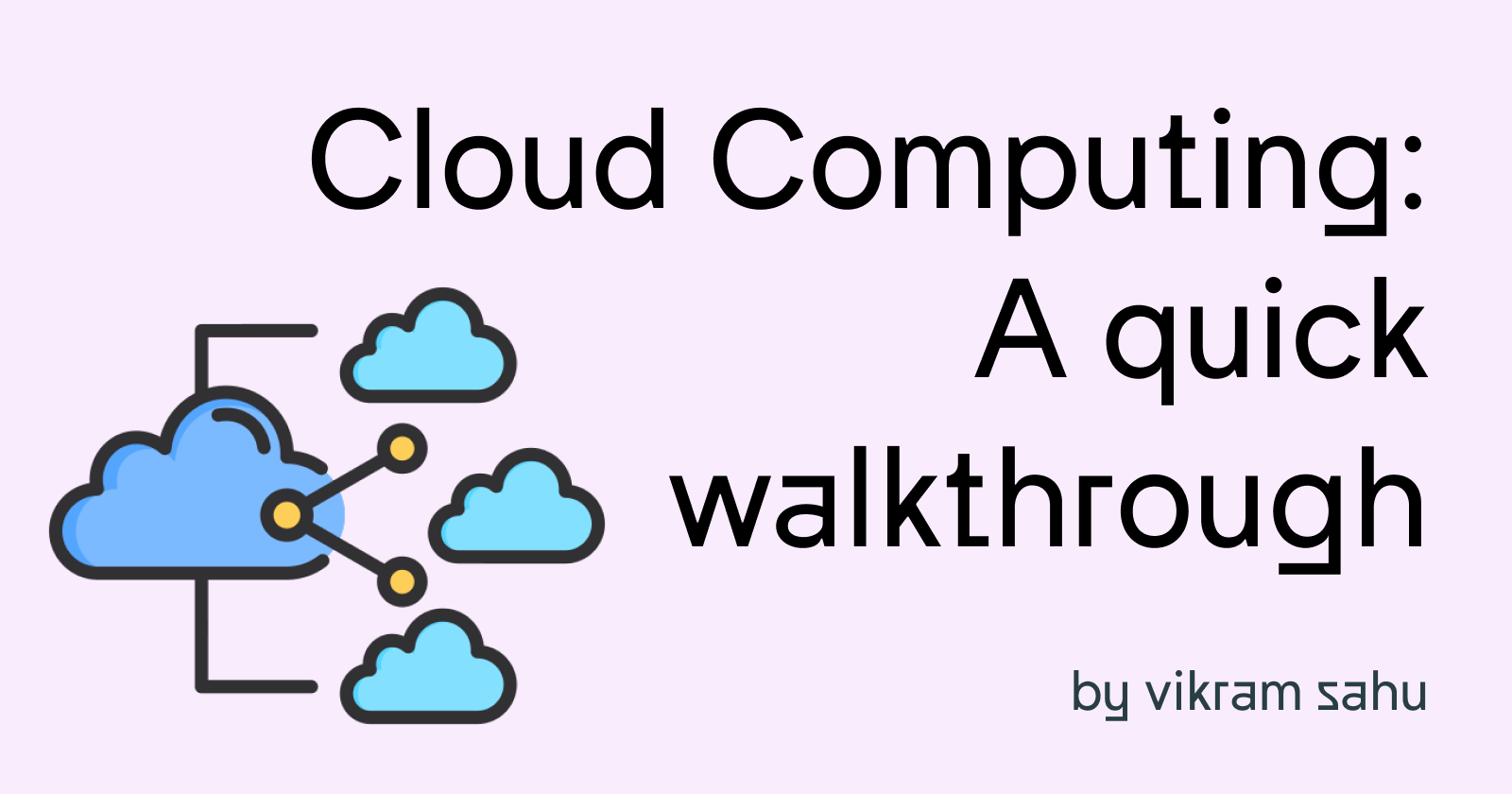Cloud Computing: A Quick Refresher
 Vikram Sahu
Vikram Sahu
Before we dive in, this article is for anyone in the tech field, regardless of your experience level. I aim to share the essentials of cloud computing and how major companies leverage it.
What is Cloud Computing?
Simply put, any app you use online is hosted in the cloud. Take Candy Crush, for example—a popular game everyone loves. When you download the app, only a small part of it is stored on your device, like the interface. All the other data—your progress, lives, connecting with Facebook friends—is stored in the cloud. Even the app itself is hosted in the cloud.
Why do we need the Cloud?
We need the cloud because it makes things easier, faster, and more cost-effective while solving several challenges that traditional setups face. Instead of managing expensive hardware and worrying about maintenance, the cloud lets you access powerful services as you need them.
For example, imagine a small business setting up an online store. Without the cloud, they’d need to buy servers, install software, and hire IT staff. This can be expensive and time-consuming. With cloud services like Shopify or AWS, they don't need to worry about buying more servers when their business grows (scalability), running out of storage, or keeping everything updated and secure. The cloud handles this for them, automatically scaling up to meet their needs and storing data safely with backups to prevent data loss.
Data security is also stronger in the cloud. Instead of a small business managing their security, cloud providers offer top-level protection with constant updates. Plus, if something happens to your physical office, your data is safe in the cloud, preventing any loss.
In short, the cloud offers easier scalability, secure storage, reduced maintenance, and peace of mind when it comes to data security and loss.
What are the different models of cloud computing?
Cloud computing has become a game-changer for businesses of all sizes. Cloud computing can be divided into service models and deployment models. understanding these models are key to making the most of this technology.
Let's break them down in simple terms.
Service Models
Cloud computing offers three main types of services: IaaS, PaaS, and SaaS. Each of these models provides different levels of control, flexibility, and responsibility.
1. Infrastructure as a Service (IaaS)
IaaS gives you access to the basic building blocks of computing, like virtual machines, storage, and networks. Essentially, it’s renting the hardware infrastructure from a cloud provider, which allows you to control and manage your own software, including operating systems, apps, and data.
Example: Imagine you run an online store. Instead of buying expensive servers, you rent virtual servers from providers like AWS, Google Cloud, or Microsoft Azure. You still control the software that runs on these servers, but you don’t have to worry about the hardware.
Benefits: Flexibility and control over your infrastructure without the cost and hassle of managing physical servers.
2. Platform as a Service (PaaS)
PaaS provides a ready-to-use platform for developers to build, test, and deploy applications. The cloud provider manages the underlying infrastructure (servers, storage, networking), so you can focus solely on your app development.
Example: Think of it like baking a cake with a pre-made cake mix. Instead of creating everything from scratch, PaaS gives you the foundation, and you just add the custom ingredients (your code). Platforms like Heroku or Google App Engine let developers create apps without worrying about managing the hardware or underlying software.
Benefits: Speed and simplicity, allowing developers to focus on building apps without worrying about servers or maintenance.
3. Software as a Service (SaaS)
SaaS delivers fully functional software applications over the internet, with no need to install anything on your local device. The cloud provider takes care of everything from the infrastructure to the software itself. You just log in and use the application.
Example: Gmail, Dropbox, or Microsoft Office 365. Instead of downloading or installing anything, you simply use the software directly from your web browser.
Benefits: No need to worry about updates, maintenance, or infrastructure. Everything is managed by the provider, and you can access the software from anywhere.
Deployment Models
In addition to the service models (IaaS, PaaS, SaaS), cloud computing also offers different deployment models based on how and where the cloud infrastructure is set up. These models define who owns and manages the infrastructure, and how it’s accessed.
1. Public Cloud
In the public cloud, the infrastructure is owned by a cloud service provider like AWS, Azure, or Google Cloud. It’s shared by multiple organizations, which makes it affordable and scalable.
Example: If you’re a startup, you might use a public cloud provider to host your website or app. You don’t own the servers, but you rent them at a low cost and scale as needed.
Benefits: Cost-effective, scalable, and easy to set up, but you have less control over the infrastructure.
2. Private Cloud
A private cloud is used exclusively by a single organization. It can be hosted on-premises or by a third-party provider. This model provides greater control and security, making it ideal for businesses that handle sensitive data, such as financial institutions or healthcare providers.
Example: A large bank might use a private cloud to store sensitive customer data securely. This gives them full control over how the infrastructure is managed and who can access it.
Benefits: Greater control and security, but higher costs and maintenance compared to public cloud.
3. Hybrid Cloud
The hybrid cloud combines both public and private clouds, allowing data and applications to move between the two. It offers flexibility by letting you keep sensitive data in a private cloud while using a public cloud for less critical tasks.
Example: A company might store its customer data in a private cloud for security but use a public cloud for its website and other non-sensitive operations.
Benefits: Flexibility, cost optimization, and the ability to scale while keeping critical data secure.
4. Community Cloud
A community cloud is shared by several organizations with common needs, such as security, compliance, or business requirements. The infrastructure is either managed by one of the organizations or a third-party provider.
Example: Government agencies or research institutions might use a community cloud to collaborate while ensuring that the data is kept secure and compliant with regulations.
Benefits: Cost-sharing and increased security for organizations with similar needs, but with limited customization options.
How Service Models and Deployment Models Work Together
The cloud computing service models (IaaS, PaaS, SaaS) and deployment models (Public, Private, Hybrid, Community) work together to create flexible solutions for different business needs.
For example:
IaaS on a public cloud: You rent servers and storage from a public cloud provider like AWS, scaling up or down as needed.
PaaS on a hybrid cloud: Developers build apps using a hybrid platform where sensitive data stays in a private cloud, but the app itself runs on a public cloud.
SaaS on a community cloud: A group of organizations shares a SaaS tool that meets their specific regulatory needs within a secure community cloud.
This combination of models allows businesses to choose the right setup depending on their size, budget, and security needs.
Why Cloud Computing Matters
The cloud has revolutionized the way businesses operate by offering scalable solutions that can adapt to growth, reduce costs, and improve data security. Whether you're a small startup using public cloud IaaS or a large corporation with a private hybrid cloud, cloud computing provides the flexibility and reliability to meet your needs.
Understanding these cloud computing models ensures you can make informed decisions and leverage the cloud to drive innovation and efficiency in your business.
Future of Cloud Computing
As cloud computing continues to evolve, new technologies and trends are emerging, further enhancing its capabilities. Here’s a look at what the future holds:
1. Edge Computing
Edge computing pushes data processing closer to where the data is being generated (like IoT devices), reducing latency and improving performance. This is especially important for applications that require real-time data processing, such as autonomous vehicles or smart cities.
2. Serverless Computing
Serverless computing allows developers to build and run applications without having to manage the underlying infrastructure. The cloud provider dynamically allocates resources, so you only pay for what you use when the app is running, without worrying about server management.
- Example: AWS Lambda is a serverless computing service that automatically scales applications and only charges for the compute time used.
3. AI and Machine Learning Integration
Cloud providers are increasingly integrating AI and machine learning tools into their services. This allows businesses to analyze large amounts of data, make predictions, and automate tasks without needing a dedicated AI team.
- Example: AWS, Google Cloud, and Microsoft Azure all offer AI and machine learning platforms that let businesses analyze customer data to predict trends or improve customer service through chatbots.
4. Multi-Cloud Strategies
Many businesses are adopting a multi-cloud strategy, using services from multiple cloud providers to avoid vendor lock-in and optimize their operations. This allows companies to leverage the strengths of different providers (e.g., using AWS for storage and Google Cloud for AI) while ensuring flexibility and avoiding reliance on a single provider.
Conclusion
Cloud computing has transformed the way businesses operate by offering scalable, flexible, and cost-effective solutions for IT infrastructure. By understanding the various cloud service models (IaaS, PaaS, SaaS) and deployment models (Public, Private, Hybrid, and Community), businesses can choose the right approach to meet their specific needs, from startups needing quick scalability to large enterprises requiring secure, private clouds.
As cloud technology continues to advance, with trends like edge computing, serverless architecture, and AI integration, it will play an even greater role in shaping the future of digital business. Whether you're looking to cut costs, improve security, or enable remote work, cloud computing offers solutions that help businesses of all sizes thrive in an increasingly connected world.
Subscribe to my newsletter
Read articles from Vikram Sahu directly inside your inbox. Subscribe to the newsletter, and don't miss out.
Written by

Vikram Sahu
Vikram Sahu
I'm a software engineer turned product manager with 7+ years of experience. I've built products from scratch and taken them to market. I've had three successful launches and one failure. career timeline: (starting latest) → Product Manager @ netcorecloud → Developer Advocate @ postman → Developer Advocate @ applozic → Developer Evangelist @ pepipost → Senior Software Engineer @ pepipost → Software Engineer @ pepipost